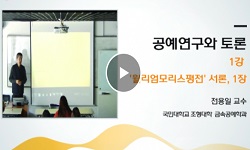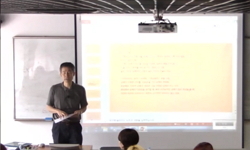At the present stage of the ‘Fourth Industrial Revolution’ represented by the high-tech industry, we believe that our society is trying to recover societal interests and crafts to retrieve our cultural identity that our society has forgotten. The ...
http://chineseinput.net/에서 pinyin(병음)방식으로 중국어를 변환할 수 있습니다.
변환된 중국어를 복사하여 사용하시면 됩니다.
- 中文 을 입력하시려면 zhongwen을 입력하시고 space를누르시면됩니다.
- 北京 을 입력하시려면 beijing을 입력하시고 space를 누르시면 됩니다.
부가정보
다국어 초록 (Multilingual Abstract)
At the present stage of the ‘Fourth Industrial Revolution’ represented by the high-tech industry, we believe that our society is trying to recover societal interests and crafts to retrieve our cultural identity that our society has forgotten. The traditional culture of Korea was devastated during the Japanese imperialism in Korea, and after the Korean War followed by the industrialization era, it was tainted and neglected in the daily lives encompassed by modern basic needs of food, clothing and shelter. The result was the cultural blending of mixed cultures and other oblivious origins descending into unrefined industrial manufacture. Today, the reason traditional crafts are back in the spotlight is because craft is the root of culture; cultural resources of present and future. However, it is difficult to find cases where our traditional crafts are suitable for modern culture and application to real life. This is because traditional crafts did not have the opportunity to be handed down through times of modernization, causing detachment from our daily lives. The value of crafts, such as ceramics, textiles, metals and woodwork, that was interconnected with real life has lost interest of the consumers with the introduction of cheaper and functional industrial products. In addition, while our society has not recognized the importance of crafts due to the indifference of crafts in industrialization process, the fact that the crafts did not develop accordingly to the ever-changing society and culture made today's crafts difficult. Likewise, as most of the housing styles have changed from the traditional, sedentary culture to the stocking culture, Soban has lost its usage and social value. Craft is the best demonstration of the overall living culture of that time period. Among the traditional woodworks of Korea, Soban is a particular furniture that reveals narratives of various regions of its environment, culture, and tradition based on where it was created. Recently, there are many works and products that reinterpret the value of the formative beauty of Soban. The purpose of this study is to find out the various directions that can be developed to modern housing culture by summarizing contemporary contents interpreted by designers and craft writers since 2000s, and traditional functions and roles of the contemporary.
참고문헌 (Reference)
1 박영규, "한국 전통목가구" 16-, 1982
2 윤숙자, "우리의 부엌살림" 178-, 1997
3 조요한, "예술철학" 219-, 2003
4 최공호, "산업과 예술의 기로에서" 251-, 2008
5 최범, "공예를 생각한다" 89-90, 2017
6 "www.woonggul.com"
7 "www.ryujongdae.com"
8 "www.jihoonha.com"
9 "www.chobyungju.com"
1 박영규, "한국 전통목가구" 16-, 1982
2 윤숙자, "우리의 부엌살림" 178-, 1997
3 조요한, "예술철학" 219-, 2003
4 최공호, "산업과 예술의 기로에서" 251-, 2008
5 최범, "공예를 생각한다" 89-90, 2017
6 "www.woonggul.com"
7 "www.ryujongdae.com"
8 "www.jihoonha.com"
9 "www.chobyungju.com"
동일학술지(권/호) 다른 논문
-
국내 아동용 가구 소재 분석을 통한 친환경성 확보 방안 연구
- 한국가구학회
- 김자경
- 2018
- KCI등재
-
웬델 캐슬(Wendell Castle) 아트퍼니처의 조형 연구 - 적층 라미네이트(stack-laminated) 작품을 중심으로 -
- 한국가구학회
- 정명택
- 2018
- KCI등재
-
- 한국가구학회
- 임지영
- 2018
- KCI등재
-
주먹장 접합부와 나비장 접합부의 인장 특성에 대한 연구
- 한국가구학회
- 김광철
- 2018
- KCI등재
분석정보
인용정보 인용지수 설명보기
학술지 이력
| 연월일 | 이력구분 | 이력상세 | 등재구분 |
|---|---|---|---|
| 2026 | 평가예정 | 재인증평가 신청대상 (재인증) | |
| 2020-01-01 | 평가 | 등재학술지 유지 (재인증) |  |
| 2017-01-01 | 평가 | 등재학술지 유지 (계속평가) |  |
| 2014-01-01 | 평가 | 등재학술지 선정 (계속평가) |  |
| 2013-01-01 | 평가 | 등재후보 1차 PASS (등재후보1차) |  |
| 2012-01-01 | 평가 | 등재후보학술지 유지 (기타) |  |
| 2011-01-01 | 평가 | 등재후보 1차 PASS (등재후보1차) |  |
| 2010-01-01 | 평가 | 신청제한 (등재후보1차) |  |
| 2009-01-01 | 평가 | 등재후보 1차 FAIL (등재후보1차) |  |
| 2007-01-01 | 평가 | 등재후보학술지 선정 (신규평가) |  |
학술지 인용정보
| 기준연도 | WOS-KCI 통합IF(2년) | KCIF(2년) | KCIF(3년) |
|---|---|---|---|
| 2016 | 0.19 | 0.19 | 0.21 |
| KCIF(4년) | KCIF(5년) | 중심성지수(3년) | 즉시성지수 |
| 0.23 | 0.22 | 0.375 | 0.02 |




 스콜라
스콜라






